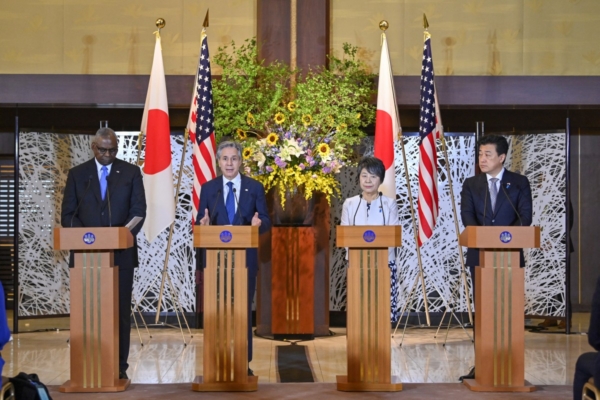On Sunday, July 28, the foreign and defense ministers of the United States and Japan held a “2+2” meeting, strongly condemning the actions of the Chinese Communist Party that destabilize the region. The U.S. announced a significant upgrade to the command structure of its forces in Japan to enhance coordination with Japanese forces in addressing the challenges faced by both nations.
According to a joint statement released by the Pentagon, the U.S. will be upgrading the military command structure in Japan. The statement mentioned, “In order to deepen interoperability and cooperation in bilateral joint operations during peacetime and contingencies, the United States intends to reorganize the U.S. Forces Japan (USFJ) to become a joint task force headquarters (JFHQ) reporting to the U.S. Indo-Pacific Command (USINDOPACOM).”
Following the “2+2” meeting in Tokyo, Defense Secretary Lloyd Austin described this upgrade as the most significant change since the establishment of U.S. forces in Japan, marking a substantial improvement in the military relationship between the U.S. and Japan in the past 70 years.
Reports from Reuters indicated that a three-star general would lead the new command headquarters in Japan, though Austin mentioned the possibility of appointing a four-star commander in the future, similar to the arrangement in neighboring South Korea.
This new command headquarters will be responsible for coordinating military operations with Japanese forces, planning joint exercises, and participating in national defense in case of hostilities. This move is aimed at keeping pace with Japan’s strengthening military capabilities, including their plan to establish a new joint military command headquarters early next year.
Despite the focus on conflicts in Ukraine and the Middle East, the Pentagon’s defense strategy highlights that China remains a primary long-term threat to the United States and its allies in the Pacific region.
The joint statement from the “2+2” meeting expressed the shared belief of the U.S. and Japan that China’s foreign policy aims to reshape the international order at the expense of other countries’ interests to serve its own purposes.
Furthermore, the U.S. and Japanese ministers jointly condemned China’s political, economic, and military coercion on other nations, companies, and civil societies, as well as its efforts to promote military modernization through technology transfer.
The ministers emphasized their opposition to China’s attempts to unilaterally change the status quo in the East China Sea, including actions that disrupt Japan’s long-standing peacekeeping efforts around the Senkaku Islands (known as Diaoyu Islands in China) and upgrades near the Southwest Islands.
The U.S. and Japan also expressed ongoing concerns about China’s rapid expansion of its nuclear arsenal. During the “2+2” meeting, the ministers reiterated their strong opposition to China’s illegal maritime claims, militarization of artificial islands, and threats and provocations in the South China Sea.
The joint statement specifically highlighted China’s actions in the region that “destabilize stability,” such as unsafe maritime and aerial interceptions, disruption of resource development in nearby waters of other countries, and risky use of coast guard and maritime militia vessels.
The ministers reaffirmed their strong stance on the Taiwan issue and the importance of maintaining peace and stability across the Taiwan Strait, which they emphasized is essential for international security and prosperity. They called for peaceful resolution of cross-strait issues.
They also sent a clear message to China that “political transitions in Taiwan should not be used as an excuse for provocative actions in the Taiwan Strait.” Earlier this year, China conducted military exercises near Taiwan during President Tsai Ing-wen’s inauguration, drawing condemnation from the U.S.
During the “2+2” meeting, U.S. and Japanese officials expressed serious concerns about China’s undermining of Hong Kong’s autonomy and freedom, as well as human rights issues in China, including those in Xinjiang and Tibet. They also condemned North Korea’s missile testing activities.
Japan provides a base for the U.S. to project military power in Asia, hosting 54,000 U.S. troops, hundreds of U.S. military aircraft, and the only forward-deployed carrier strike group of the U.S. Navy.
With increasing military threats to Taiwan from China, Japan has become more concerned about the potential outbreak of conflict in the Taiwan Strait. Given its geographical proximity, a conflict in the Taiwan Strait could pose a threat to Japan’s security. Consequently, Japan has been actively seeking U.S. protection and increasing its military budget.
In 2022, Japan announced a plan to double its defense spending to reach 2% of its Gross Domestic Product, in response to the evolving security environment and challenges facing the U.S.-Japan alliance, as well as to keep up with Japan’s enhanced military capabilities, including the establishment of a new joint military command headquarters slated for early next year.

